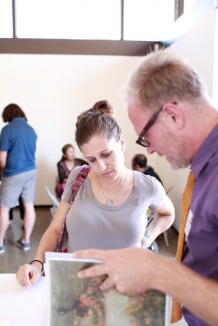Building Community: Making Space for Art
Urban Institute: Maria Rosario Jackson
This report asks how art spaces might be incorporated into comprehensive community planning and revitalization strategies. It urges policy makers, urban planners, and community developers to look at arts and culture through a broad lens, considering the impact of both individual and collective art experiences on health, education, and economic development, as well as a range of other social concerns such as civic engagement, transmission of heritage, intergenerational and cross-cultural understanding, social cohesion, and citizen stewardship of their communities.
Extracts
Urban planners, community developers, and policymakers in various fields, including the arts, do their best to improve existing communities and design new places in which to live and work. However, when thinking about art and culture, they often revert to conventional notions of art spaces: large venues for the presentation of professional art, cultural districts concerned primarily with the consumption of art products, and live/work spaces for artists. But how might art spaces be incorporated into comprehensive community planning and revitalization strategies if we better understood (a) the full range of artistic activity that people value, (b) the importance of arts and creative outlets for all people, (c) the roles that artists play in society, and (d) the kinds of art spaces that robust cultural vitality requires?
In addition to considering conventional venues and activities related to the presentation of professional art for consumption, it is necessary to think about a broader range of activities and places implicated in the concept of cultural vitality. A place with cultural vitality has a character and identity based on the creative and artistic contributions and aspirations of its citizenry. Research has linked dimensions of cultural vitality to economic development, attachment to place, positive health outcomes, and civic engagement, among other desirable effects.
First, cultural participation ranges from amateur to professional activities; often includes the cultural expressions of ethnic, racial, age, and special interest groups that may not be validated or adequately represented in large mainstream cultural institutions; and occurs in diverse places.
Second, while cultural participation has been understood primarily as audience participation, people often participate in cultural activities in various other ways. People also want to participate actively in creative processes. They want to go to concerts and plays and to see visual art, but they also yearn to make music, dance, tell their stories, and create meaningful objects and experiences that express their thoughts, feelings, and aesthetics.
Third, people engage in arts and cultural activity for reasons inherent to art itself—for the aesthetic and technical attributes—but frequently also because they want other benefits for themselves, their families, and their communities. . . . There is also greater and more sophisticated research about how the arts contribute to education outcomes and economic development, the two most developed areas of research on the effects of the arts.
Through recent research concerned specifically with artists involved in “hybrid” work—often outside the conventional cultural sector and at the intersection of art and other fields—we found that such artists are driven by one or some combination of the following desires: (a) to be of service to communities or to pursue social justice–related issues; (b) to connect to multiple and nontraditional publics and markets—audiences, collectors/consumers, students, amateur artists—in different ways; and (c) to deal with problems outside the arts and be at the cutting edge of problem solving and invention, often in research contexts.
In the United States and other countries, there is a heightened consciousness of creativity as a major economic engine. Interest in the “creative economy,” “creative cities,” and similar ideas have led to an increased awareness of the presence of artists and their possible impacts on communities. At the same time, there have been some important strides in research to develop a more nuanced understanding of the economic and social effects of the arts (and artists), although more of this work is needed.

